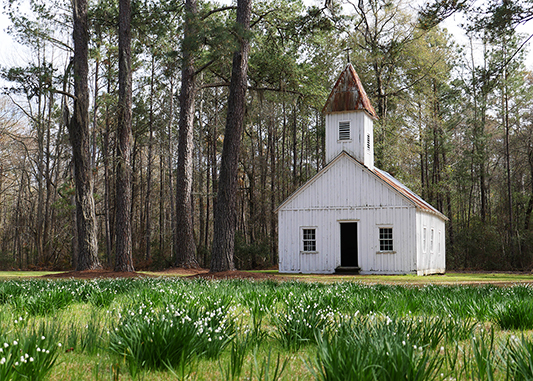The lives of the residents of Hobcaw’s African-American villages were closely intertwined. In the foreground of this 1929 photograph are Nettie Kennedy, daughter of William and Daisy Kennedy, and her groom, Rainey Gardner. The Kennedy children were born in Strawberry Village and the family later moved to a dwelling near Hobcaw House. The Gardner family lived in Barnyard Village.
Here, members of the wedding party are crossing the street from Reverend Moses Jenkins' home to Friendfield Church, where Nettie Kennedy and Rainey Gardner were married.


In 2014 this large “presentation” Bible was found in an antique store by a friend of Hobcaw Barony and returned to the Belle W. Baruch Foundation. Bernard Baruch presented the Bible to the congregation in 1940 in memory of Reverend Moses Jenkins and lay leader Charlie McCants.
Bernard Baruch mentions in his autobiography that his wife, Annie Griffen Baruch, who was Episcopalian, also gave a large Bible to Friendfield Church before her death in 1938. It went missing and has never been found.
In this Baruch home movie from the late 1930s or ’40s, children from Hobcaw’s African-American villages attend an Easter egg hunt at Bellefield, Belle Baruch’s home. As a group of white guests looks on, Belle and her secretary Lois Massey hand out Easter baskets and ice cream, and a young white boy, possibly the son of a Baruch employee, gives out balloons.
These traditions can be seen as representing what historian Dale Rosengarten describes as the Baruchs’ “great benevolence and great condescension” toward the African-American residents of Hobcaw Barony.
Friendfield Church, an enduring specimen of vernacular architecture, was built between 1890 and 1900 and remodeled under the direction of Bernard Baruch around 1905. It replaced a smaller chapel that was located a bit farther away, at the end of Clambank Road near the King’s Highway. The present location of the church, in a prominent place along the village road, is in keeping with its importance as a community center. Its steeple, elegant in its simplicity, probably contained a bell that would have called people together for worship and other events.
According to the National Register of Historic Places, the church “is a good example of a rural chapel, typical of lowcountry freedmen’s churches built after about 1870. These are generally modest frame structures, often including steeples, arched windows and other design elements common in white churches of the time.”
